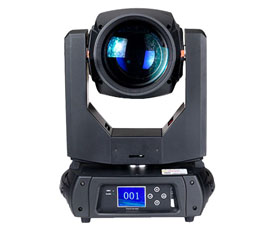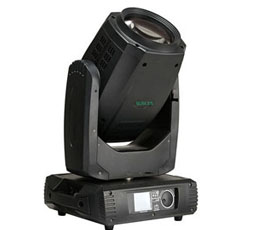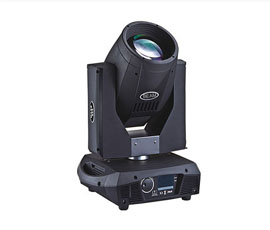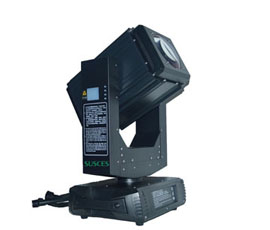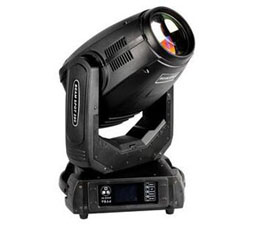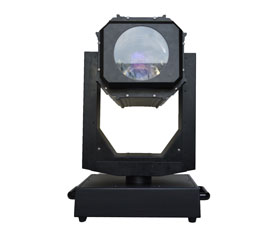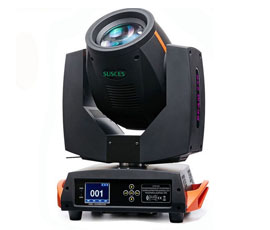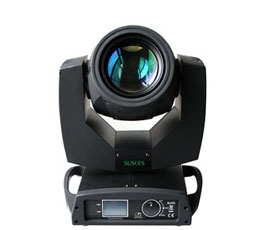
Constructing a personal monitoring system for dealing with complex stage applications
In the stage performances, the sound reinforcement system mainly includes live sound reinforcement and stage monitoring sound reinforcement, the two are closely linked. From the working principle, both belong to the sound reinforcement system, the sound signal pickup is the same, are to complete the sound signal conversion amplification and sound energy redistribution.
In the face of complex live performances, will be set on the stage alone set a console for the stage monitor. Stage listening sound reinforcement is to let the actors on stage to hear their own performances, singing and speaking sound reinforcement system. Compared to the production of television signals and live sound reinforcement, the stage monitoring sound reinforcement often has a very important role. Although the monitoring part of the sound reinforcement system is often regarded as the second, but it should also cause the sound division enough attention, in fact, the stage monitoring sound reinforcement is the actors own voice only reference, largely decided to perform The success or failure.
1 stage monitoring of the individual needs
Live sound mixing console is usually set in the back of the audience, and the stage monitor mixer is often set in the side of the stage, the audience can not see the monitor and always see the stage on the actors (to facilitate their exchange) The As shown in Figure 1. Both sources are from the stage (except for playback equipment) interface box, the two systems take the required. The sound mixing console picks up almost all of the signals while the monitor mixer only picks up the desired signal. In the process of debugging the two sides also have different focus, live sound tuning tuning actor and band voice in the field of balance and sound, and the balance of the stage monitor tuning will be based on the different needs of actors and bands and the venue and the band between Position, but the requirements of the sound is not as high as the live sound. Live sound tuning adjustment is a whole balance, while the stage monitor tuning adjustment is a number of balance.

Figure 1 stage monitor mixer often placed on the side of the stage
At present, in order to stage the visual beauty and ease of operation, stage monitor speakers are gradually being replaced by wireless personal monitoring system. Flexible and compact wireless personal monitoring system is not limited by the distance and sound blocking, by more and more sound division of the favor. In addition, the sound division in order to pursue the sound of the stage clean, to avoid listening to the sound of the speaker and then picked up by the microphone, will recommend all the stage monitoring are using personal monitoring system and no longer use the traditional return speaker, which has been accepted by some actors The Regardless of the form of the stage monitor, the role is the same, that is, with a better monitor the quality of performance with the actors.
In the performance of special music, especially through the personal listening system to the program sound to the actors wearing headphones, will make the actors hear more real, so that performers have a greater stage mobility flexibility, can reduce the stage The degree of dispersion under the premise of the maximum feedback before the gain, and get a better mixing effect. Occasionally, the personal listening system is used in conjunction with the stage return speaker. In the debugging of wireless personal monitoring system, generally in series with an equalizer, the headset to adjust the tone. Figure 2 for the Shure PSM1000 personal monitoring system.

Figure 2 Shure PSM1000 personal monitoring system
2 to build a different needs of the individual monitoring system
2.1 Stereo / mixed / mono monitor mode
Personal monitoring system is sometimes connected to a stereo input, sometimes connected into a single channel input, which depends on the needs of the actors may be. Wearing a headset actor is generally not only listen to the voice of the individual monitoring system, but also to hear the sound of the stage monitor the speaker.
Personal monitoring system in the human voice, reverberation and the proportion of music and the stage monitor the proportion of speakers in the premise, often the vocals will be part of the mixed mode to send a little more. But each actors habits and requirements are different, for example, some actors in the personal listening system headphones accompaniment volume is high, some actors require a large voice, etc., according to different circumstances at any time to adjust.
2.1.1 Stereo mode
Stereo mode emits dual channel signals. As shown in Figure 3.
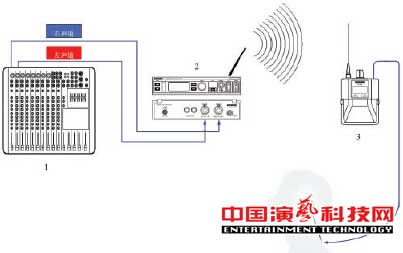
图Figure 3 Schematic diagram of the stereo monitor mode
(1) connect the mixer to the personal monitoring system transmitter; (2) set the transmitter output mode to stereo mode; (3) set the personal monitoring system receiving mode for the stereo mode. 2.1.2 Mixed mode Mixed mode allows the actor to listen to two channels from the two different channels at the same time, but also balance the volume of both. Such as
4所示。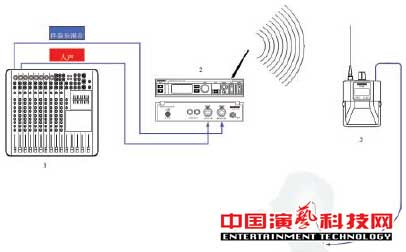 Figure 4 Schematic diagram of the mixed listening mode 2.1.3 Mono mode Mono mode Transmit monaural signal to the pockets receiver. (1) Connect the mixer to the transmitter; (2) Set the transmitter output mode to mono mode. 2.2 Multi-Channel Monitor System Application Mode 2.2.1 Stereo Mode Use LOOP output L and port to copy audio signals to other devices. As shown in Figure 5。
Figure 4 Schematic diagram of the mixed listening mode 2.1.3 Mono mode Mono mode Transmit monaural signal to the pockets receiver. (1) Connect the mixer to the transmitter; (2) Set the transmitter output mode to mono mode. 2.2 Multi-Channel Monitor System Application Mode 2.2.1 Stereo Mode Use LOOP output L and port to copy audio signals to other devices. As shown in Figure 5。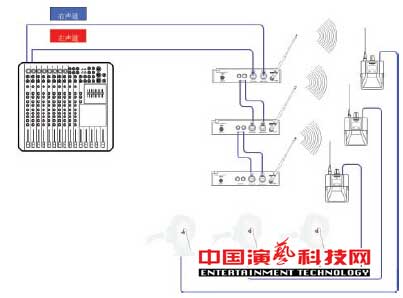 Figure 5 multi-channel monitoring stereo mode 2.2.2 mixed mode multi-channel monitoring hybrid mode to meet the scene in the performance of different artists to monitor the complex needs. As shown in Figure 6. When the actor uses the personal monitoring system, often on both sides of the stage to set up the audience effect of the microphone, the audience to reflect the collection, such as the audiences applause, laughter and live effect sound, properly sent to the actors headset, so that it does not Because of wearing a headset and can not hear the audiences voice. It is listening to the sound engineer in the use of personalThe ability to monitor the system should be better able to enhance the interaction between the actors and the audience.
Figure 5 multi-channel monitoring stereo mode 2.2.2 mixed mode multi-channel monitoring hybrid mode to meet the scene in the performance of different artists to monitor the complex needs. As shown in Figure 6. When the actor uses the personal monitoring system, often on both sides of the stage to set up the audience effect of the microphone, the audience to reflect the collection, such as the audiences applause, laughter and live effect sound, properly sent to the actors headset, so that it does not Because of wearing a headset and can not hear the audiences voice. It is listening to the sound engineer in the use of personalThe ability to monitor the system should be better able to enhance the interaction between the actors and the audience.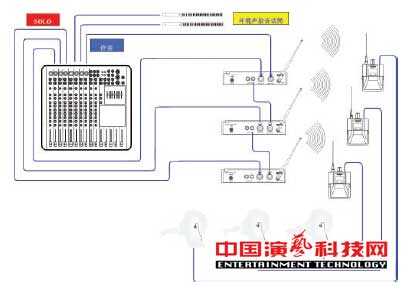 Figure 6 multi-channel monitoring mixed mode In addition, sometimes also to the stage to supervise or direct a microphone, the field instructions through the wireless return to the lead singer or musicians, so that live performances better synchronization, which is difficult to traditional monitor speakers Done it. 2.3 connected to the stage monitor speaker application mode connected to the stage monitor speaker application mode to meet the live performance environment can not be wired to the stage monitoring needs. As shown in Figure 7.
Figure 6 multi-channel monitoring mixed mode In addition, sometimes also to the stage to supervise or direct a microphone, the field instructions through the wireless return to the lead singer or musicians, so that live performances better synchronization, which is difficult to traditional monitor speakers Done it. 2.3 connected to the stage monitor speaker application mode connected to the stage monitor speaker application mode to meet the live performance environment can not be wired to the stage monitoring needs. As shown in Figure 7.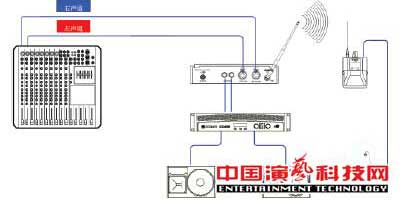 Figure 7 connection monitor speaker application mode 3.4 access recording equipment application mode access recording equipment application mode to meet the live performance environment can not be wired to the tape recorder monitoring needs. As shown in Figure 8.
Figure 7 connection monitor speaker application mode 3.4 access recording equipment application mode access recording equipment application mode to meet the live performance environment can not be wired to the tape recorder monitoring needs. As shown in Figure 8.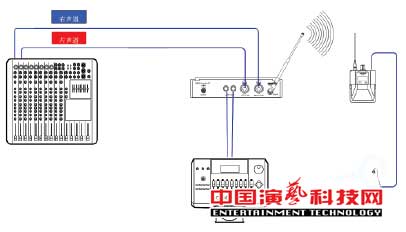 Figure 8 Connect the recording device application mode
Figure 8 Connect the recording device application mode
